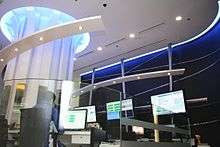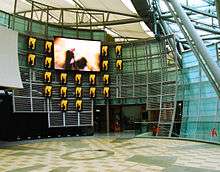Cyberport
| Hong Kong Cyberport | |
|---|---|
|
Cyberport 1 and 2 | |
| General information | |
| Status | Complete |
| Location | Cyberport Road, Telegraph Bay, Hong Kong |
| Coordinates | 22°15′42.5″N 114°7′48.77″E / 22.261806°N 114.1302139°ECoordinates: 22°15′42.5″N 114°7′48.77″E / 22.261806°N 114.1302139°E |
| Owner | Hong Kong SAR Government |
| Management | Hong Kong Cyberport Management Company Limited |
| Design and construction | |
| Architect | Wong Tung & Partners Limited |

Cyberport (Chinese: 數碼港) is a business park in Hong Kong consisting of four office buildings, a hotel, and a retail entertainment complex. It describes itself as a "creative digital community" with a cluster of technology and digital content tenants.[1] It is owned and managed by Hong Kong Cyberport Management Company Limited which is wholly owned by the Hong Kong SAR Government.
Project background
In March 1999, the Hong Kong government announced their intention to develop a "cyberport", which would help local businesses capitalise on the rapid growth of the Internet. The government hailed it as development where information technology and multimedia would be nurtured so that future demands of these industries could be met. According to the press release by the Commerce and Economic Development Bureau, only one-third of the site would be for residential, the sale of which would then help finance the Cyberport development concept.[2] The Cyberport is billed as the home to one incubation facility for ICT startups called Entrepreneurship Centre providing office space, financial aid package,training, micro fund and network access to the investment community.
The Hong Kong government inked a partnership deal with the Pacific Century Group (PCG) to develop a 26-hectare (64-acre) site with open sea view at Telegraph Bay in Pok Fu Lam, Hong Kong Island, at a total cost of HK$13 billion. It was announced as part of the 1999 budget by then-Financial Secretary, Donald Tsang. It was also hoped that this development would help the HKSAR's economy rebound after the 1997 Asian financial crisis, and bring a "strategic cluster of information technology and services companies situated in a world-class setting".[2] The "strategic telecommunication node" was due to be formed due to its close proximity to the proposed "Teleport" in Chung Hom Kok.[2] Touted benefits include "a range of shared facilities for tenants, including a multi-media based network, telecommunication links, media laboratory, cyber library and other information technology and services support facilities. There will also be educational, entertainment and recreational facilities related to information technology and services for local visitors and tourists".[2]
As part of the deal, PCG would construct a 92,000-square-metre (990,000 sq ft) office complex with a 28,000-square-metre (300,000 sq ft) shopping mall and a 173-room hotel that would be put out to management. Title to these properties would be transferred to the government at zero cost, while PCG received land for 420,000 square metres (4,500,000 sq ft) of residential housing in exchange, and would reap 64.5 percent of the profits from their sale.[3]
The construction of the Cyberport portion consisting of four office buildings, The Arcade and Le Meridien Cyberport Hotel was completed in phases between 2002 and 2004. The residential developments consists of approximately 2,800 units or houses was completed in phases between 2004 and 2008.
Controversy
Granting the project to Pacific Century Group (PCG) controlled by Richard Li, son of Hong Kong's wealthiest man Li Ka-Shing, to develop the site generated much controversy.[4][5] Three private and wholly owned companies, namely, Hong Kong Cyberport Development Holdings Limited, Hong Kong Cyberport Management Company Limited and Hong Kong Cyberport (Ancillary Development) Limited (collectively referred to as the "Cyberport companies") have been set up under the Financial Secretary Incorporated (FSI) to oversee the implementation of the project. The project was criticised as unnecessary government intervention in the property sector. The granting of the project to PCG without the benefit of a formal open tender attracted criticism for lack of transparency; other interested developers complain of being sidelined.[5][6] According to critics, Cyberport was in reality a residential property project in disguise, as it has arguably failed in its mission of becoming a high-technology hub for the city.[7][8] Eurasia Review suggested that the government land was injected into the project at under value. The overall rationale of the project has been questioned: details that have emerged about the planning and budgeting for the project indicate that 75% of the area developed is residential, and office space allocated for the technology companies would only be around 17% of the total. Also the "shared facilities" make up part of a small 18,000-square-metre (190,000 sq ft) block which includes houses and apartments.[7]
The project had the reputation of being a "ghost town", as the government owned portion suffered low occupancy.[5] Fifteen companies signed letters of intent with the developer, including Hewlett-Packard, IBM, Microsoft and Yahoo, but only three moved in at the initial opening due to a technology slump.[9] The government rejected accusations of favouritism by arguing that PCG's presence as an anchor tenant would be an advantage for marketing to prestigious international technology companies. In addition, tendering was bypassed ostensibly to shorten the sensitive time frame to bring forward the economic benefits of the project.[10] PCG later hived off the residential property interests into a shell company separate from the telecoms operation so that the shell company would receive the residential housing sales revenues; it was also accorded right of first refusal to redevelop sites of 60 existing telephone exchanges of PCCW, the telecoms operator.[3][8] In October 2004, David Webb cited lack of transparency in the government's business dealings and demanded audited financial accounts and directors' reports for three companies related to the project to be released under the non-statutory Code on Access to Information.[11]
Housing
Bel-Air Residence
Bel-Air (貝沙灣) is a luxury residential development in Cyberport. The development is split in six phases; phase 1 and 2 are referred to Residence Bel-Air and Phase 3 is referred as Bel-Air on the Peak. Pase 1 and 2 each have a clubhouse and 7 blocks that are about 48 floors tall. Floor 40 and upwards are flats that have the area of two flats combined into one, creating over 3,200 square feet (300 m2). All of which feature sky gardens with ocean views. Enumeration of "Block 4" and all 4th floors of each block has been avoided for superstitious reasons. However the management company neglected to omit 4 when naming the construction phases.
Each floor of "Bel-Air on the Peak" has three apartments, 2 larger units, 'A' and 'C' and a smaller 2-bedroom unit 'B'. The clubhouse of "Bel-Air on the Peak" is significantly newer with more artistic features. They maintain an indoor pool, gym, restaurant, snooker room, and children's game room.
Bel-Air has two clubhouses: the Bay Wing and Peak Wing. They feature a spa, indoor and outdoor swimming pool, game room, gym, children's play room, restaurant, and personal cinema. Each floor of the "Residence Bel-Air" has two flats with 3 bedrooms, 1 kitchen, and a balcony. Additionally there are single family homes near "Residence Bel-Air".
Services and facilities


IT and telecom
- 1–10 Gbit/s Internal Private Network (IPN)
- 120 Channels Satellite Master Antenna Television System (SMATV)
- Fibre and Copper Blockwiring (BW)
- IP Telephony and Unified Messaging System (UMS)
- Network Operations Centre (NOC)
- Tenant Central Data Exchange (CDX)
- Wireless Local Area Network (WLAN)
Facilities
- Cyberport Conference and Exhibition Centre
- Technology Centre
- Entrepreneurship Centre & Connect-Space @ Cyberport
- Mobility Experience Centre
- Smart-Space @ Cyberport
- Independent Schools Foundation Academy
- The Arcade
- Le Meridien Cyberport Hotel
- Fitness Centre – GoGYM
See also
- Sailfish Alliance – Cyberport Hong Kong is one the partners in the Sailfish Alliance.
- Jolla – In Cyberport Hong Kong the Jolla company has located its R&D Centre
- Hong Kong Free Press
References
- ↑ "Cyberport website". Cyberport.hk. Retrieved 3 April 2012.
- 1 2 3 4 "$13 billion Cyberport project announced". Commerce and Economic Development Bureau (Communications and Technology Branch). 3 March 1999.
- 1 2 "After Selling PCCW, in which industry will RICHARD LI find his future?". Asia Sentinel.
- ↑ "ASIA-PACIFIC – Hong Kong signs cyberport deal". BBC.
- 1 2 3 "Cyberport's Chief Executive on Web 3.0 and Technology in Hong Kong". The Wall Street Journal.
- ↑ Ko, Eric (21 March 1999). "Cyberport critics get stake hint". The Standard. Hong Kong. Retrieved 11 January 2007.
- 1 2 "Hong Kong: Revelations In SHK Bribery Case; Collusion Between Politicians And Property Tycoons – OpEd". Eurasia Review. 16 July 2012.
- 1 2 Andrew Coffey. "Cyberport tech park still has doubters". The Age.
- ↑ "Multinationals back away from Hong Kong's IT park". Taipei Times.
- ↑ "Secret deal on Cyberport dismissed". info.gov.hk. 16 March 1999.
- ↑ "Cyberport Secrets". webb-site.com.
External links
| Wikimedia Commons has media related to Cyberport. |
